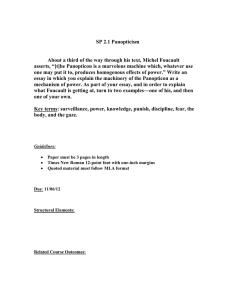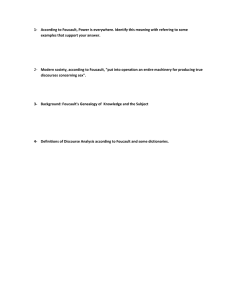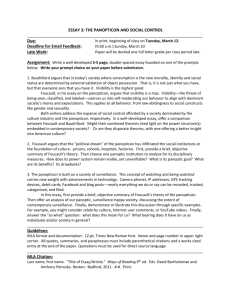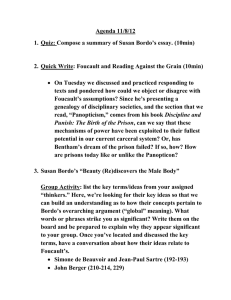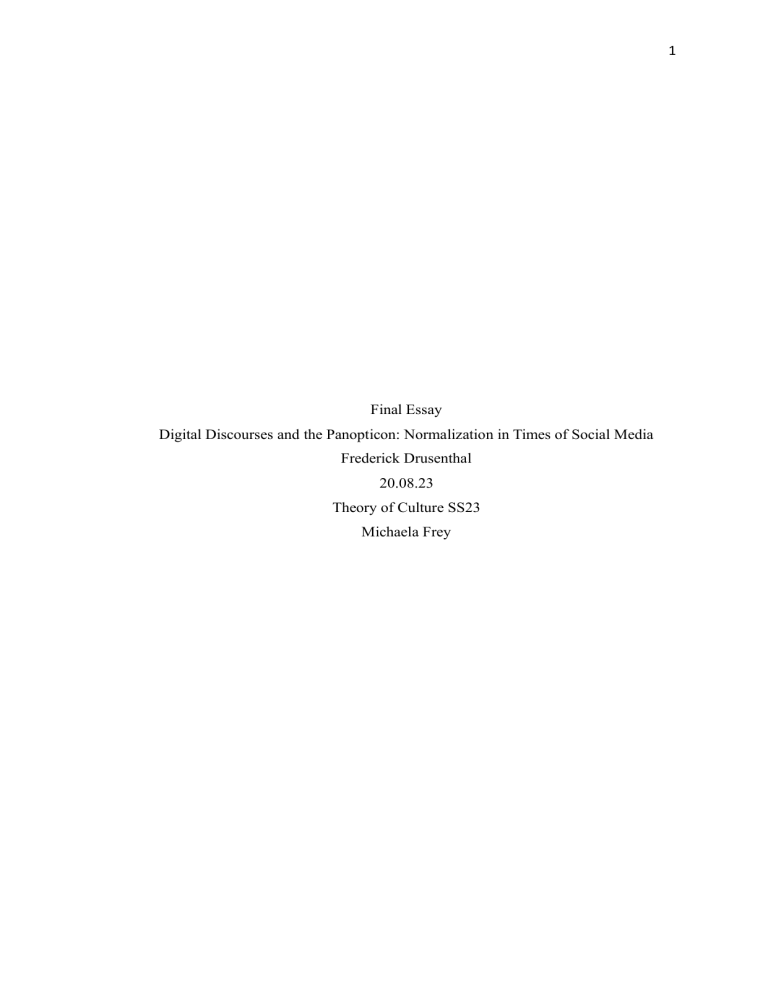
1 Final Essay Digital Discourses and the Panopticon: Normalization in Times of Social Media Frederick Drusenthal 20.08.23 Theory of Culture SS23 Michaela Frey 2 “For nonconformity the world whips you with its displeasure” (Ralph Waldo Emerson) We live in a world that is guided by social norms, restrictions, and rules. It is hard to imagine our society without some of those guiding principles that continuously make us a constitutive and dependent part of a larger social body. In order to sustain those, each time has come up with its own means of disciplining the people – either through surveillance or penal systems from public torture to disciplinary institutions. In his 1975-published work Discipline and Punish: The Birth of the Prison, Foucault (1984) argues that since the 18th century, the coercion those means of control have exerted upon us still is often veiled in our daily thoughts and practices. Many examples of social culture display underlying principles that promote and normalize certain behaviors. Foucault (1984, p. 217) considers these to be embedded in the Panopticon's formal design. This surveillance system creates a feeling of constant observation and evaluation for those under its watch, which can lead to the social assimilation of certain behaviors. Social media is a common example of how assimilating power is integrated into our daily lives (such as Facebook, Instagram, Twitter, TikTok, and many more). These multimedia platform services not only offer information and entertainment but also shape our social behavior and relationships in significant ways. They prove to have the ability to sustainably change how we communicate and interact with others (Joo & Teng, 2017; Korda & Itani, 2013). In addition, the advent of social media has undeniably opened a novel avenue for the establishment of prevailing norms. These possess the capability to significantly shape our capacity to present and articulate ourselves, whether in the digital realm or in the physical world. To understand how social media can be a medium to exert assertive power structures on its users, I will argue that Foucault’s theories of the Panopticon and Normalizing Power offer valuable insights for examining how social media platforms facilitate extended surveillance, control, and normalization of individuals, profoundly impacting contemporary society’s confrontation with power, identity, and homogeneity. 3 I. Foucault’s Panopticon and Digital Disciplinary Potential Foucault’s Discipline and Punish traces the historical evolution of disciplinary power through the panopticon, a concept inspired by Jeremy Bentham’s architectural design for a prison. The panopticon’s central tower allows a single observer to monitor all inmates without their knowledge, inducing in them a state of self-discipline through the fear of possibly being scrutinized at all times. This structure thus facilitates social control and obedience within its institutional settings. Foucault uses the concept of the panopticon as a metaphor to refer to the mechanisms present in various institutions, such as factories, hospitals, and schools (p. 17). He suggests that the panopticon is an essential aspect of all modern disciplinary institutions, as it is “organized as a multiple, automatic, and anonymous power; for although surveillance rests on individuals, its functioning is that of a network of relations from top to bottom, but also to a certain extent from bottom to top and laterally” (Foucault, 1984, p. 192). These surveilling mechanisms have severe repercussions on the public and end up “leav[ing] no zone of shade” (p. 192) as even the ones entrusted with supervising the others from a central point of view can be constantly viewed. Far apart from applying only in the obvious disciplinary institutions – such as schools, prisons, factories, etc. – it is all kinds of social spaces that can be possibly invaded and thus surveilled by the gaze of others. This machinery-like form of surveillance, thus, constitutes a sphere in which the boundaries of public and private start to blur and behavior is constantly exerted through a sort of socially normative filter, as I will discuss more thoroughly later on. Within the digital age, social media platforms have emerged as powerful entities employing a digital panopticon model of sorts. An increasing number of daily users voluntarily participate in their surveilling mechanisms, exchange their personal information, and communicate behavior online. Algorithmic surveillance and data mining enable social media companies to gather vast amounts of information, creating virtual panopticons where users’ actions are observed, recorded, and analyzed without their constant awareness (Fuchs, 2012, p. xix). Therefore, social media companies function as covert surveillance entities, operating from within their applications without having to reveal their presence to users. Accordingly, they can exercise – possibly disciplinary – power without facing the same consequences of being seen as human disciplinary guards in Foucault’s panopticon would. By constructing impersonal and algorithmically hidden surveilling mechanisms, social media companies have the possibility to exert veiled power as a central structural feature of their platforms. For example, the Instagram algorithm constantly considers and analyses a user's content, interests, and behavior on the platform. This metadata is then used to make the users’ experience “as pleasant as possible” 4 (Hirose, 2023, p. 1), prolonging the time and attention devoted to Instagram by offering optimized personal content and advertisements. Subsequently, it becomes possible for the companies to achieve refined surveillance of their users based on rather passive and silent information-gathering, making it possible to observe certain behaviors and predict, reinforce, and change them. II. The Spectacle of Visibility and Self-Presentation Within this digital panopticon, individuals are engaged in a constant spectacle of selfpresentation. Users often seek validation, popularity, and social capital on social media. Consequently, they meticulously construct their online personas based on the perceived norms of their peers. This frequently results in a performative creation of their digital identities, as users often internalize and adhere to social media norms, effectively disciplining themselves to fit within the prescribed boundaries of the platforms. Foucault describes this process as the normalization of behavior. Instead of punishing by atonement or repression, the “perpetual penalty” that highlights and sanctions socially nonconforming behavior “compares, differentiates, hierarchizes, homogenizes, excludes. In short, it normalizes” (p. 195). Although, again, he relates this explicitly to the power structures embedded in typical disciplinary institutions of his time and historical studies, similar effects can be observed in the social dynamics of social media platforms. Behavioral studies by Colliander (2019) and Sunstein (2019) have demonstrated clearly how the structure of online discourses has amplified individuals' conformity to opinions, standpoints, and self-presentation. It seems that social media has amplified the presence of information with specific values in a platform that greatly influences the course of contemporary public discourse. Whenever one encounters the narratives and ideals of content on social media platforms, it can bias their perception of the subject matter as it can “introduce, through this “value-giving” measure, the constraint of a conformity that must be achieved” (Foucault, 1984, p. 195). It is interesting to note that this conformity to a norm also leads to the conscious formation of more unique identities online. Individual users can compare themselves on a wider scale through social media engagement and see how they differ from the perceived norm. Foucault notes that “within a system of formal equality, […], the norm introduces, as a useful imperative and as a result of measurement, all the shading of individual differences” (p. 197). Social media companies utilize this shading of individual differences to support personalized content, allowing users to differentiate themselves from others on the platform. Like this, the individualization of their presence is tied to the assimilation to more fragmented norms and 5 consumption patterns. The utilization of normalizing power on social media is therefore enhanced by the fact that it affects individuals on a highly personalized level. This process is further amplified by the bubbled social media discourses, as I will discuss more thoroughly later on. Although this is a process not unique to social media – the concept has been wellestablished in social psychology and is now supported by research in neuroscience (Morgan & Laland, 2012b) – it does reach new amplitudes of potential instrumentalization of those effects for the purpose of profit. Most social media platforms are driven by an attention economy, where the commodification of users’ attention is a lucrative source of revenue. The constant exposition to notifications, likes, and comments exerts the platforms’ disciplinary mechanisms on their users. By conditioning the user to seek approval for their social media identity, the algorithms perpetuate their presence and engagement on the platform, which increases the profit of the companies behind the platforms. Foucault grasped it well when he argued that “by means of such surveillance, disciplinary power became an “integrated” system, linked from the inside to the economy and to the aims of the mechanism in which it was practiced” (p. 192). The spectacle of visibility and self-presentation has given social media platforms an incredible potential to commodify each user's personality by means of normalizing power. III. Contemporary Dynamics and Outlook As users of social media platforms often unconsciously submit personal information and intimate details of their lives, the boundaries between the public and the private become blurred. Many have now evolved into platforms where showcasing privacy has become the norm for achieving worldwide recognition, popularity, and accomplishment. A frequently occurring example is the emergence of influencers on social media, who are users that gain fame by showcasing large parts of their personal lives publicly and are paid by companies to promote and potentially influence people's consumption habits by means of their publicity (Goméz, 2019). As previously discussed, many social media users tend to adopt the behavior they come across online, leading them to conform to as well as reproduce the normalizing power exerted digitally by those influencers and other digital actors. The loss of privacy leads to heightened user vulnerability, making individual consumers susceptible to manipulation and control by external actors, including governments and corporations. As Bradshaw & Howard (2017) have pointed out, a lot of those powerful external actors have used their resources to manipulate 6 masses of people online, making use of the filter-bubble effect1 to advance their own agendas (p. 15-16). The reason for the erosion of privacy is the high level of sophistication in social media algorithms that relentlessly monitor and customize content based on users' interests and actions in real-time. Conclusions In conclusion, it becomes evident that the contemporary dynamics of social media usage and its implications for social life are vast. Through the omnipresence of the manifold digital platforms and their refined means of surveillance and control, it can be argued that they have established a digital form of Michel Foucault’s panopticon. Further, this essay has aimed at demonstrating how the digital panopticon and its normalizing power surpass previous forms of disciplinary institutions in their potential for conscious instrumentalization and how this redefines the user’s confrontation with power structures, identity, and homogeneity. Recent research has shown that the algorithms and economic interests behind the platforms companies as well as the powerful actors who contribute to the discourse on them, continuously advance in exercising their coercive means to advance their agendas and foster their revenues. Foucault’s theories seem to be a useful tool in order to conceptualize the adaptability and refinement of disciplinary technology in the age of social media. 1 The filter-bubble effect describes how social media users are targeted and categorized by certain interest groups and therefore only see news and contents confirming their previously held assumptions and views. For more, see: Pariser, E. (2011). The filter bubble: What the Internet is Hiding from You. Penguin Press HC. 7 Citations (APA 7): Bradshaw, S., & Howard, P. (2017). Troops, Trolls and Troublemakers: A Global Inventory of Organized Social Media Manipulation. In Computational Propaganda Research Project. (pp. 1–37). Oxford Internet Institute. Colliander, J. (2019). “This is fake news”: Investigating the role of conformity to other users’ views when commenting on and spreading disinformation in social media. Computers in Human Behavior, 97, 202– 215. https://doi.org/10.1016/j.chb.2019.03.032 Foucault, M. (1984). The Foucault Reader. Pantheon Books. Vintage. Fuchs, C. (2012). Internet and surveillance: The Challenges of Web 2.0 and Social Media. Gómez, A. R. (2019). Digital Fame and Fortune in the age of Social Media: A Classification of social media influencers. aDResearch: Revista Internacional de Investigación en Comunicación, (19), 8-29. Hirose, A. (2023). 2023 Instagram Algorithm Solved: How to get your content seen. Social Media Marketing & Management Dashboard. https://blog.hootsuite.com/instagramalgorithm/ Joo, T. M., & Teng, C. E. (2017). Impact of Social Media (Facebook) on Human Communication and Relationships: A View on Behavioral Change and Social Unity. International Journal of Knowledge Content Development & Technology, 7(4). Korda, H., & Itani, Z. (2013). Harnessing social media for health promotion and behavior change. Health promotion practice, 14(1), 15-23. Morgan, T. J. H., & Laland, K. N. (2012b). The biological bases of conformity. Frontiers in Neuroscience, 6. https://doi.org/10.3389/fnins.2012.00087 Sunstein, C. (2019). Conformity: The Power of Social Influences. New York, USA: New York University Press. https://doi.org/10.18574/nyu/9781479896585.001.0001
